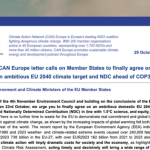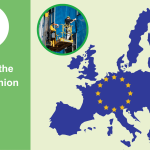The climate crisis remains the defining challenge of our time and Europe will play a significant role in determining whether we can avert the worst impacts of rising temperatures or whether people and the planet continue heading towards climate breakdown. In November 2019, the European Parliament declared a state of climate and environmental emergency, following the dire warnings of scientists, citizens and civil society that the world is not on track to meet the objectives of the Paris Agreement.
In response, the European Union agreed on a target to achieve climate neutrality by 2050 and to increase its nationally determined contribution (NDC). In addition and as a central part of the European Green Deal, the European Commission launched a comprehensive revision of the EU’s climate and energy policy framework and architecture, the so-called ‘Fit For 55’ package, in summer 2021. The main objective of the review was to bring EU policy in line with the updated climate objectives enshrined in the EU Climate Law, including the target of achieving at least -55% net emission cuts by 2030.
The ‘Fit For 55’ legislative package contains proposals to update legislation affecting all economic sectors, including upgrades to the EU’s main climate and energy legislation. Over the past years and despite the turmoil caused by the COVID19 pandemic and the Russian war against Ukraine, negotiations largely remained on track and climate and energy legislative updates proceeded steadily and simultaneously, in a slightly sequenced manner.
The following briefing focuses on the outcomes of the three central climate files – the EU Emissions Trading System (ETS), the Effort Sharing Regulation (ESR) and the Land Use, Land Use Change and Forestry (LULUCF) – as these are the three files formally implementing the EU’s overall climate target for 2030. It is important to keep in mind that these files were negotiated simultaneously as part of a wider set of climate legislative pieces, many of which are closely interlinked and in parallel to the EU energy files which were concluded later and are not the focus of this briefing.
Based on the assessments in this briefing, both on the three individual files and on their collective impact, CAN Europe highlights the following recommendations:
- The EU and its Member States need to make use of every measure possible to further decrease emissions before 2030 in order to achieve at least -65% emission cuts by that date and climate neutrality no later than in 2040;
- These measures should include a consistency check of the revised legislation in light of the remaining EU greenhouse gas emission budget and the EU’s equitable contribution to the Paris Agreement objectives, informed by the European Scientific Advisory Board on Climate Change (ESABCC);
- When implementing the revised legislation, Member States should plan for higher domestic emission reductions than foreseen under their respective national targets in order to enable the EU to move well beyond the -55 net emission reduction target. Such increased ambition should be driven bottom-up, particularly through the ongoing process of preparing their National Energy and Climate Plans (NECPs);
- The EU and its Member States need to advance the socially just transformation of the economy. Beyond strengthening instruments such as the Social Climate Fund, Europe needs to strengthen its protection of vulnerable groups and middle and low income households against climate risks and poverty. At the same time, heavy polluters, fossil fuel companies, overconsumption and excessive material use need to be taxed much stronger and revenue redirected at scale towards renewables, nature protection and the deep transformations necessary to achieve climate neutrality.
DOWNLOAD FULL BREIFING HERE



